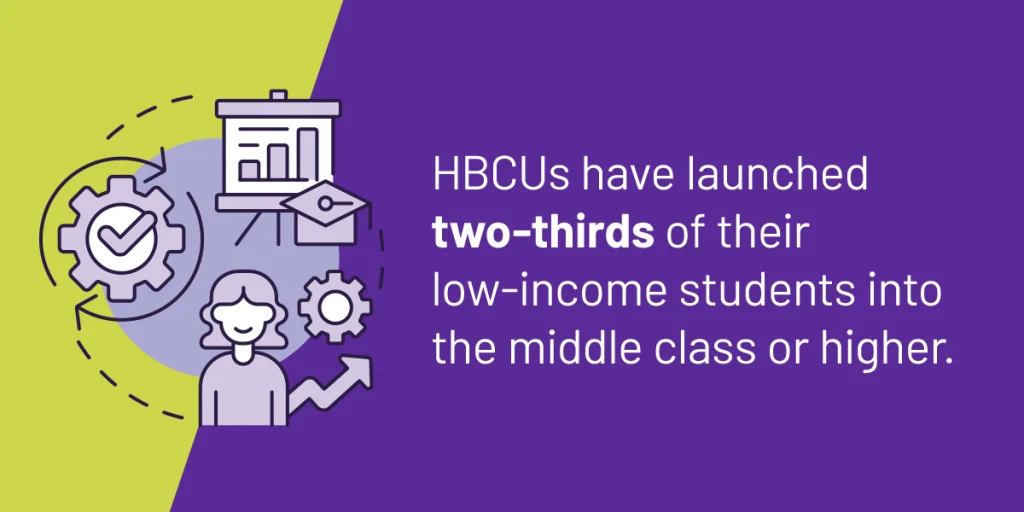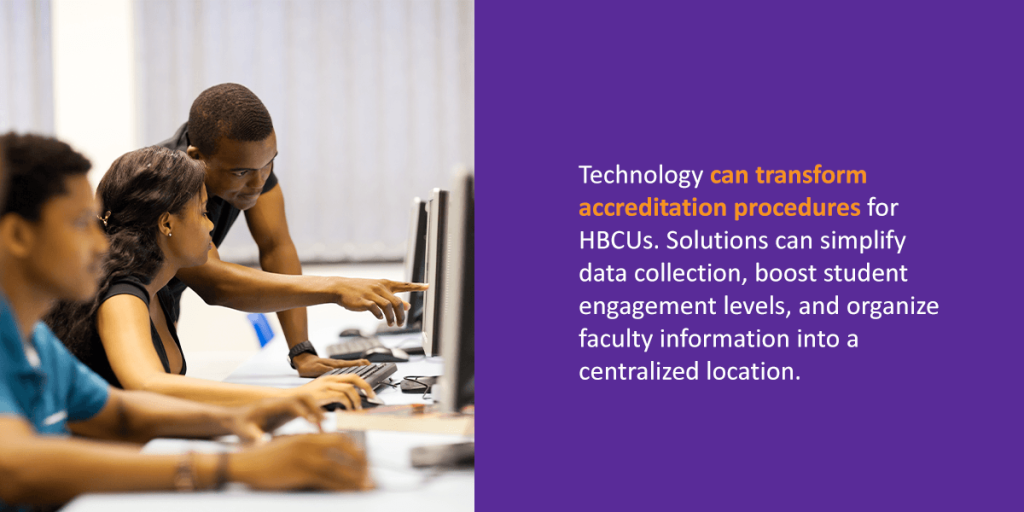



In an educational system that has often replicated the inequities of American society as a whole, historically Black colleges and universities (HBCUs) have provided critical spaces where Black students and students of color can thrive. Founded in the 19th century to counter existing institutions’ exclusion of Black students, HBCUs have always had to hone their ability to create maximum impact from limited resources.
Their successes are incredible. HBCUs have launched two-thirds of their low-income students into the middle class or higher. Despite representing just 3% of all two- and four-year nonprofit institutions participating in federal student financial aid programs, HBCUs have awarded 17% of the bachelor’s degrees earned by Black students nationwide. Additionally, about a quarter of STEM degrees earned by Black graduates since the early 2000s have come from HBCUs.

Unfortunately, such strides have been in spite of continued underfunding, even amid renewed attention to this complex issue at both the state and federal levels. One particular area of concern has been in the demanding — and, as some critics say, biased — accreditation process, where HBCUs suffer when being held up for comparison to larger, wealthier, majority-White institutions that benefit from their demographics’ greater access to affordable education.
As the assessment coordinator at Howard University, Britt Spears-Rhymes, M.S., points out that it’s these reverberations of historical discrimination that make HBCUs’ approach to assessment pivotal. Spears-Rhymes, who is also pursuing a PhD in Higher Education Leadership and Policy Studies at Howard, recently gave a presentation, “Advancing Black Education Through Assessment Technology.” In it, she explores how HBCUs can leverage assessment and new technology to streamline their processes, elevate their stories, and fully utilize their resources.
As the engine of accreditation, assessment is frequently viewed as a major energy guzzler, an extremely labor-intensive process that requires its own devoted workforce to run smoothly. For HBCUs that are already operating on less, it can seem insurmountable.
But here, Spears-Rhymes believes that a shift in perspective can be transformative. For many institutions, though they might not realize it, “the assessment process is… a lot of times, things that people are already doing.” Ensuring that everyone in your institution has a deep understanding of what assessment is, and then integrating assessment-focused thinking into the culture of your institution, she suggests, can help HBCUs streamline their processes, improve their impact, and prevent unnecessary consumption of valuable time.
“If you don’t have the people to do the work, then the work either doesn’t get done, or it doesn’t get done well, right?” But, in fact, says Spears-Rhymes, this is where staff and faculty education, as well as the right student success solutions, can play a powerful role.
For Howard, some of this aid has come from an equity and student success solution powered by predictive analytics, which helps colleges and universities keep underserved students engaged, increase student retention, and optimize the chances of degree and certificate completion.
By providing the right people with the right software training and tools, HBCUs are empowered to make what they have work harder for them. This, says Spears-Rhymes, and changing the perception that the work of assessment is “an extra task,” can produce institution-altering results.
The purpose of accreditation in higher ed, and whether it should be framed primarily as quality improvement or as accountability, has been a topic of debate. But, generally speaking, the desired end goal of accreditation is to facilitate institutions’ consistent delivery of better educational outcomes for students. Widespread skepticism in recent years about accreditors’ ability to actually bring about meaningful institutional changes, however, keeps this rigorous process a contentious one.
For HBCUs, who have historically been excluded by accreditation associations — and who continue to be sanctioned at disproportionately higher rates today — this skepticism runs even deeper.
“It can be a tug of war trying to figure out how to get information, and specifically, with the history of HBCUs within the larger Black community, there’s often a distrust with sharing information — sometimes internally — but certainly externally,” notes Spears-Rhymes. “I sometimes get scared when people ask me to share information… because I know that there’s this institutional context, and this Black-community context, and it’s HBCU culture, that information is not shared because it may be used for personal gain or it may be used to show us in a negative light.”
As an example, she points to retention rates at HBCUs versus non-HBCUs. For certain HBCUs, looking at graduation numbers alone paints a picture of relative academic underperformance. However, responsible reporting — which is not always a given — must take into account that these are not apples-to-apples comparisons. Critical context includes acknowledging student factors likely to be more prevalent in HBCU demographics, such as coming from a low-income family, being the first in a family to go to college, having first-generation status, and coming from a high school that lacks resources to adequately prepare its students for college-level courses.
Given these nuances, it’s imperative that HBCUs take control of their narratives, rather than letting their stories be told by others. As Spears-Rhymes points out, accreditation can be an opportunity for HBCUs to do just that. Because the process necessitates assessment at a level of depth and rigor that yields large amounts of data, having the tools to organize, make sense of, and apply that data is essential.
“We get ranked X, Y, Z at U.S. News & World Report every year. But how are we articulating that?” asks Spears-Rhymes. “I have found that the student success solutions really help with that.” One of the solutions used to this end at Howard is Watermark Student Success & Engagement, which allows the institution to turn data from existing institutional systems into actionable insights, identify and engage students that need immediate support, and use validated research to guide intervention strategies for struggling students.

How can HBCUs make sure that the right people are getting the right training and tools? One way might be to take a closer look at whether and how silos — or the “stratified and specialized” groupings that have evolved in higher education administration — are operating in your institution.
“From an organizational theory perspective… silos do make sense,” says Spears-Rhymes. “But it gets tricky sometimes when you’re looking to review student learning holistically.”
While silos can provide tight-knit, like-minded groups who support one another’s goals with more conviction because of a deeper shared understanding of their approach, they can also prevent problem-solving that holds in mind multiple perspectives at once.
Just as sharing information externally, when done strategically, can contribute to stronger public-facing narratives for HBCUs, sharing information internally can open up streams of information, constructive critiques, and varied perspectives across departments within HBCUs that will provide the kinds of invaluable insights that drive institutional improvement.
Howard, for example, uses Watermark Planning & Self-Study to streamline its system for gathering, understanding, reflecting on, and acting on assessment and other programmatic data.
But, as Spears-Rhymes notes, it’s important for every HBCU to consider their unique assessment objectives, and ask themselves what kinds of concrete results they’d like to see from the process. Their answers can help inform which technology solutions they choose to enlist, and how those solutions should work together.
Learn more about Watermark solutions, and how deep and targeted training for faculty and staff can help shut down silos, free up more resources, and encourage diverse, cross-department thinking that positions HBCUs for success in assessment and beyond.

























































































































































































































































































































































































Submit this form to schedule a meeting with one of our reps to learn more about our solutions. If you need customer support instead, click here.